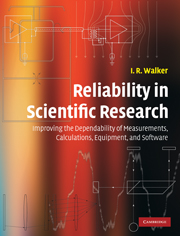 Reliability in Scientific Research
Reliability in Scientific Research Published online by Cambridge University Press: 05 June 2012
Introduction
In books on mathematical methods in physics, there is a very frequent tendency to ignore the subject of errors, and what can be done to prevent them. In conversations on this topic, two common points of view are: (1) error prevention is an ability that is acquired through practice (i.e. it is not something that is taught explicitly), and (2) one just has to be careful. While both viewpoints contain elements of truth, it is also true that techniques exist for preventing and detecting errors. Furthermore, these can be passed on explicitly like other skills (i.e. they do not have to be learned through hard experience.) Such techniques are the subject of the present chapter. These are mostly concerned with the prevention of errors in symbolic (i.e. algebraic) calculations, rather than numerical ones, unless otherwise indicated.
Sources and kinds of error
Conceptual problems
The first and most subtle types of error in analysis in general arise from conceptual problems: understanding the essential physics of a problem and expressing it in mathematical form.
Transcription errors
A second very common type, frequently encountered when calculations are done by hand, is transcription errors. These occur when formulae and numbers are copied from one line in the calculation to the next, often taking place when the handwriting is untidy and cramped. They also arise very frequently if more than one mathematical operation is attempted per line in the calculation.
To save this book to your Kindle, first ensure [email protected] is added to your Approved Personal Document E-mail List under your Personal Document Settings on the Manage Your Content and Devices page of your Amazon account. Then enter the ‘name’ part of your Kindle email address below. Find out more about saving to your Kindle.
Note you can select to save to either the @free.kindle.com or @kindle.com variations. ‘@free.kindle.com’ emails are free but can only be saved to your device when it is connected to wi-fi. ‘@kindle.com’ emails can be delivered even when you are not connected to wi-fi, but note that service fees apply.
Find out more about the Kindle Personal Document Service.
To save content items to your account, please confirm that you agree to abide by our usage policies. If this is the first time you use this feature, you will be asked to authorise Cambridge Core to connect with your account. Find out more about saving content to Dropbox.
To save content items to your account, please confirm that you agree to abide by our usage policies. If this is the first time you use this feature, you will be asked to authorise Cambridge Core to connect with your account. Find out more about saving content to Google Drive.